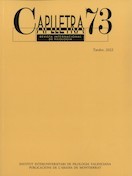Discovery-learning in grammar education: a study on anaphoric pronouns
DOI:
https://doi.org/10.7203/caplletra.73.24639Palabras clave:
anaphoric pronouns, discovery-learning, grammar laboratory, explicit knowledge of language Resumen
Resumen
In the last decades, in the Portuguese educational context, as in other countries, grammar has been a central topic of debate in L1 education. Since 2001, a perspective of grammar education as explicit knowledge of language has prevailed in the Portuguese L1 curriculum. From this perspective, inspired by proposals of the Anglo-Saxon movement of language awareness, the main goal of grammar education is to develop the implicit knowledge that children already have and use into an increasingly reflected and explicit knowledge. In this conception, which supposes that «most of data needed to teach grammar is in children’s heads» (Hudson 1992), discovery-learning approaches seem to be particularly adequate. Founded by Bruner and brought into grammar education by Hudson, this learning approach gives the student a central role and reflection upon language is stimulated through scientific reasoning. In this article, we will refer to a study on the comprehension of anaphoric pronouns in which a discovery-learning approach, the «grammar lab», was used with 20 students in grade 4. Proposed by Duarte (1992, 2008) after Hudson (1992) and sharing characteristics with other approaches (e.g., the «linguistic inquiry» by O’Neil and colleagues), the grammar lab allows students to use their intuitive knowledge and guides them to observe linguistic data, to test and validate hypotheses about language. In our study, which investigated relations between explicit knowledge and reading, students were guided to reflect upon different properties of anaphoric pronouns to develop strategies to identify antecedents of pronouns in a reading task. Some of the materials used will be presented and the main results obtained, which show positive effects of this approach in grammar education, will be discussed.
 Descargas
Descargas
Descargas
Publicado
Cómo citar
-
Resumen360
-
PDF 554
Número
Sección
Licencia
El autor o autora que dirija un trabajo a la redacción de Caplletra para ser publicado tiene que ser la persona titular legítima de los derechos de explotación. La legitimación para la publicación del trabajo tiene que incluir también las imágenes, las tablas, los gráficos y otros materiales que puedan complementar el texto, con independencia de si es su autor o autora.
Copyright. Al publicar el trabajo en la revista, el autor o autora cede a Caplletra. Revista Internacional de Filologia los derechos de explotación (reproducción, distribución y comunicación pública), tanto para la edición impresa en papel como para la versión electrónica.
Todos los trabajos publicados en Caplletra se encuentran bajo una licencia Creative Commons del tipo Reconocimiento-NoComercial-SinObraDerivada 4.0.
RESPONSABILIDAD
Caplletra. Revista Internacional de Filologia no se identifica necesariamente con los puntos de vista sostenidos en los trabajos que publica.Caplletra. Revista Internacional de Filologia declina toda responsabilidad derivada de cualquier vulneración eventual de los derechos de propiedad intelectual que pudiera ser llevada a cabo por los autores o autoras.






